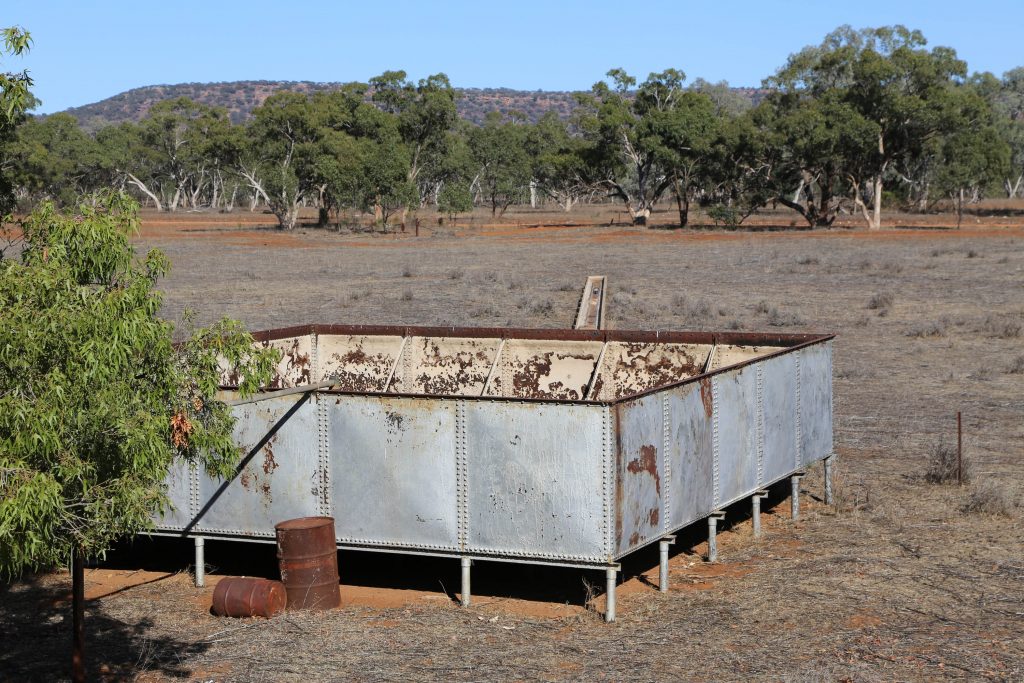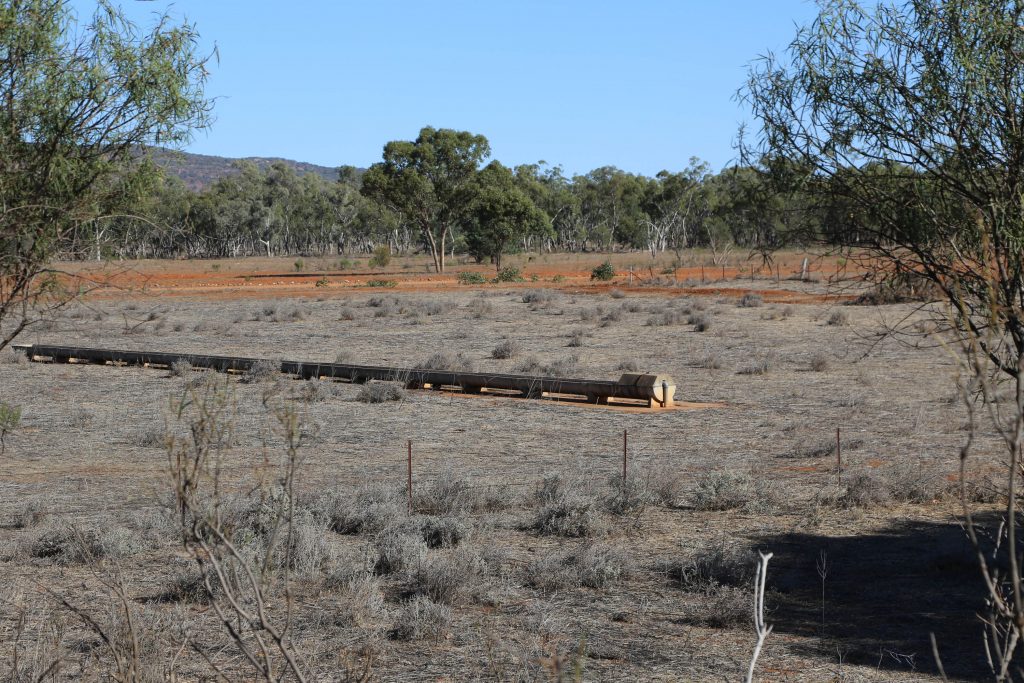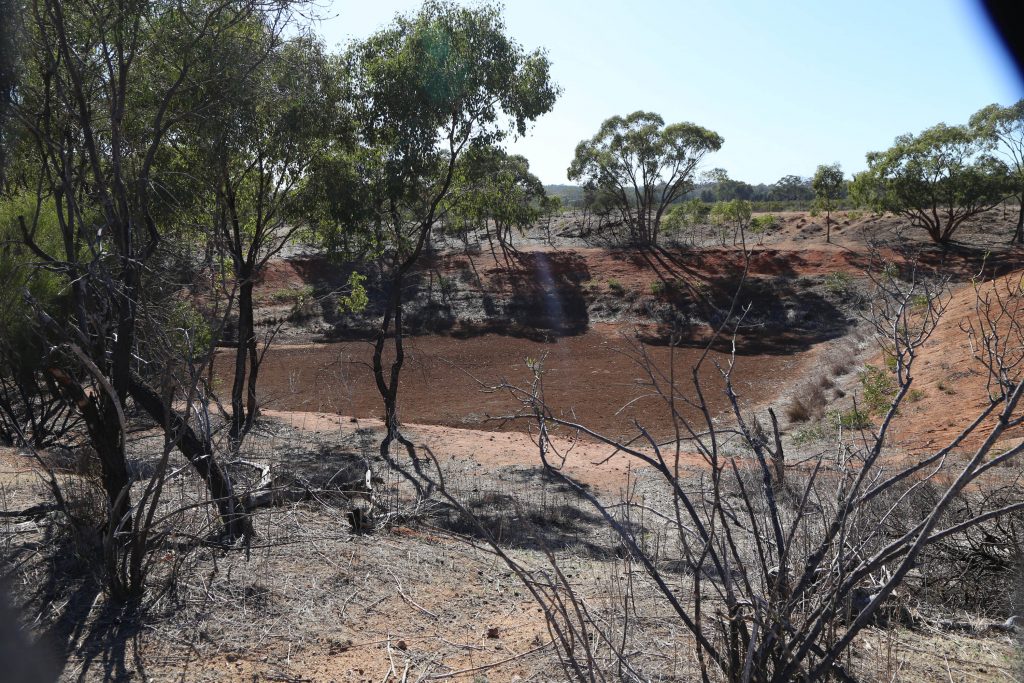Wagga Tank Public Watering Place No 7 on Travelling Stock Reserve 253
A superficial historical overview
Travelling Stock Routes and Reserves (TSRs), are a unique Australian Pastoral Institution. They allowed pastoralists to move stock from one area to another, and most importantly, to southern markets. Provision of watering points was the most critical of all development works on the TSRs, with bores, dams, windmills and troughs providing adequate watering places for every day that stock were travelling.
In the 1840s and 1850s explorers were busy finding new country and hot on their heels came the pastoralists with their flocks and herds. By the 1860s, the North-South stock Routes were experiencing heavy traffic.
The earliest newspaper reference found to date indicated that Wagga Tank on the road from Hillston to Cobar, situated on Travelling Stock Reserve 253, had been recommended to the Department of Public Works for Gazettal as a ‘Reserve’ on 20 April 1876. This action coincided with the transfer by the Department of Public Works to the Department of Mines of all watering places in the interior. These watering places were then designated with the title ‘Public Watering Place’. Wagga Tank was listed as ‘on the road from Cobar to Hillston, 15 miles from Rockholes’.
During the late 1860s and early 1870s there was a proliferation of water boring and tank sinking, as pastoralists sought ways of ensuring their stock arrived at southern markets in at least ‘store’ condition. A total of 19 new watering places, opened up a watered road from Bourke on the Darling to the Carrathool Railway Station on the Murrumbidgee – 350 miles.
While travelling stock routes and reserves were to be found in all Australian states, except Tasmania, it was New South Wales that led the nation in the development of travelling stock routes and reserves. Usually tanks were sited about 12 to 15 miles apart – a day’s travelling for large stock such as cattle, and an area ranging from 320 acres to 640 acres of pasture surrounding the tank, was ‘reserved’ for travelling stock on their overnight camp.
Each tank was equipped with a windmill and troughs, and initially came under the control of the Public Works Department. However in 1885 these assets were transferred to the Department of Mines who named, numbered, surveyed and mapped them. They then instituted processes which enabled them to collect charges from drovers who used the 2,000-odd tank reserves.
To enable the charges to be collected, cottages were built, the tank reserve fenced and tenders invited for the lease of the area. The successful tenderer had to reside in the cottage, and was entitled to retain two thirds of the revenue collected. The remaining one third was remitted to the Department of Mines in Sydney.
The depth of water in various tanks was published weekly in newspapers circulating in the area. In July 1886 Wagga Tank had 17ft. of water. In September 1886 is had 18ft 6in, with Mt Hope tank at 19ft. By February 1887, Wagga Tank was at 20ft. These weekly measurements continued to be published up until 1918. During the great drought of the mid 1890s, newspapers also gave pasture reports. In 1895, the depth of water in Wagga Tank on the Hillston to Cobar Road was listed as 5ft 9in and state of pasture ‘bad’.
In March 1886, the NSW Government Gazette advised that Tenders for a 5 years lease of Wagga Tank would be received up until 11 May 1886. Somebody must have been appointed, because the Sydney Evening News was able to report that Wagga Tank held 17ft of water for the week ended 28 July 1886.
Such was the use made of the Wagga Tank Reserve, that in 1909, an extension to the Reserve was promulgated.
In 1911 an iron tank was installed at Wagga Tank PWP No 7 on the Hillston to Cobar Road and in March 1914 repairs to the cottage were authorised and carried out. Just when the cottage was built is yet to be determined, but it is reasonable to assume that there must have been some type of dwelling provided from 1885 for the lessee who was to collect charges from drovers using the area, and provide a weekly report of water depth and pasture condition at the Reserve.
In December 1925 Wagga Tank was placed under quarantine, due to the presence of Anthrax, but by January 1926, the Quarantine Notice had been rescinded.
In 1924 a new windmill was installed, but exactly when the original one was installed has yet to be established. In 1941 another new windmill was erected at Wagga Tank, and Yathong Station made an offer to purchase the old one for £5. Whether the Yathong offer was accepted has yet to be determined. However in March 1945, the Riverine Grazier carried an advertisement for ‘one windmill at Wagga Tank near Roto’, and then advised in the 25 May 1945 edition, that ‘a tender of £5 for the old windmill at Wagga Tank has been received. Its acceptance has been recommended’.
Advertisements in the Public Notices columns of various newspapers circulating in the area appear at regular 5 yearly intervals up until the commencement of World War II. In June 1935 the Hillston Spectator and Lachlan River Advertiser carried a ‘For Lease’ advertisement describing Wagga Tank Public Watering Place No 7 on the Cobar-Hillston Road, 70 miles from Hillston as having an area of 1,280 acres; the PWP 640 acres and TL 640 acres. The tank had a capacity of 18,000 cubic yards, and there was a 7 roomed weatherboard cottage on site.
After the end of World War II, with the advent of motor transport moving stock from station to market, use of the Travelling Stock Routes began to decline in the late 1950s. Although dearer that the drover, motor transport got stock to their destination quicker and without any loss of condition. Revenue from the TSRs fell and as a consequence, maintenance on the tanks suffered.
Just when Wagga Tank ceased to function as a watering point for travelling stock, has not yet been established. However in September 1946, the lessee was admonished by the Hillston Pastures Protection Board the controlling authority, for not living at the site.
By the 1970s many of the tanks and reserves on TSRs were being leased to adjoining landholders.
The system of TSRs that developed in Australia is clearly a pastoral institution of unusual scope and significance. Its evolution began at an early stage in the settlement history of the continent and its longevity is notable.
The Australian system of Travelling Stock Routes/Reserves has been striking in its development; remarkable in its extent; unusual in its longevity; and unique in its functioning. In 1977, Tom McKnight, Professor of Geography at the University of New England, Armidale NSW forecast that the TSRs and their associated infrastructure might simply become a phenomenon of history.



